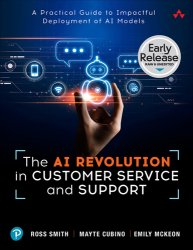 Название: The AI Revolution in Customer Service and Support (Early Release)
Название: The AI Revolution in Customer Service and Support (Early Release)Автор: Ross Smith, Emily McKeon, Mayte Gonzalez
Издательство: Addison-Wesley Professional/Pearson Education
Год: 2024
Страниц: 409
Язык: английский
Формат: pdf, epub
Размер: 10.3 MB
Generative AI has made amazing advances in the last year, and customer service and support is one of the most important areas where this new technology can have an immediate impact. While the technology is not yet in a place where it will fully replace agents and support engineers, it can do wonders to dramatically improve customer experience while also contribute to the optimization of productivity in various ways. This book help readers understand how and where to incorporate AI technology into the flow of the customer experience.
In the 2020s and beyond, AI is entering a new frontier of generative technologies, which aim to create novel and realistic content, such as images, texts, sounds, and videos. Generative technologies use deep learning models, such as generative adversarial networks (GANs), variational autoencoders (VAEs), and large language models (LLMs), to generate content that is indistinguishable from human-produced content. Generative technologies have various applications, such as art, entertainment, education, and communication.
One of the most exciting and challenging areas of generative technologies is natural language generation (NLG), which generates natural language text from a given input, such as an image, a keyword, or a prompt. NLG has many applications, including summarization, translation, dialogue, storytelling, and content creation. However, NLG also poses many technical and ethical challenges, such as ensuring the generated texts’ quality, diversity, coherence, and fairness. A key component of NLG is the language model (LM), a probabilistic model that assigns a probability to a sequence of words or tokens. LMs can generate new texts by sampling tokens according to their probabilities or evaluating the likelihood of existing texts. LMs can be trained on large corpora of text data, such as Wikipedia, books, news articles, or social media posts, using Deep Learning techniques, such as RNNs or transformers. The development of LMs has gone through several stages, reflecting the advances in computational power, data availability, and algorithmic innovation. There are four main development stages of LMs: Statistical language models, Neural language models, pre-trained language models, and large language models.
Large Language Models (LLMs) are the latest and most advanced stage of LMs, which aim to build very large-scale and powerful LMs that can generate natural language texts across multiple domains and tasks, given minimal or no supervision. LLMs rely on massive amounts of computation and data and use sophisticated optimization and regularization techniques, such as self-attention, dropout, or layer normalization, to train billions or trillions of parameters. Some of the most prominent examples of LLMs are GPT-3, GPT-3.5 (Instruct GPT) and GPT-4, developed by OpenAI.
LLMs have demonstrated remarkable capabilities and achievements in natural language understanding and generation, surpassing previous state-of-the-art models and even human performance in some tasks. Some of the most notable and influential LLMs include GPTs, BERT, XLNet, T5, and DALL-E, which have been developed and released by leading research labs and companies, such as OpenAI, Google, Facebook, and Microsoft. LLMs have also enabled and inspired the creation and innovation of various applications and products, such as chatbots, assistants, recommender systems, content generators, summarizers, translators, analyzers, or synthesizers, which have been deployed and adopted by various industries and sectors, such as education, health, business, media, entertainment, or art, among others. LLMs have thus revolutionized and democratized the field of natural language processing and generation, opening up new possibilities and opportunities for research, development, and impact.
One possible application domain of LLMs is customer support, which involves providing assistance and guidance to customers or users of a product or service through various channels, such as phone, email, chat, or social media. Customer support is an essential and integral part of any business or organization, as it affects customer satisfaction, retention, loyalty, advocacy, brand reputation, revenue, and growth. LLMs can offer a solution to some of these challenges by augmenting or automating some aspects of customer support, such as answering frequently asked questions, providing information or instructions, resolving issues or problems, collecting feedback or ratings, generating reports or summaries, or escalating cases or tickets, and so on. LLMs can leverage their natural language abilities, such as understanding, reasoning, generating, or adapting, to provide personalized, contextualized, and relevant responses or actions based on the ‘customer’s input, profile, history, or preferences, as well as the product or service specifications, policies, or updates. LLMs can also learn from the data and feedback collected from the interactions and improve their performance and accuracy over time, using techniques such as Reinforcement Learning, active learning, or transfer learning.
Скачать The AI Revolution in Customer Service and Support (Early Release)